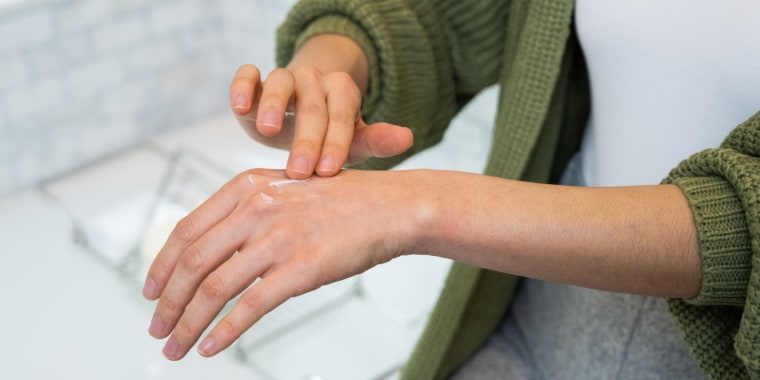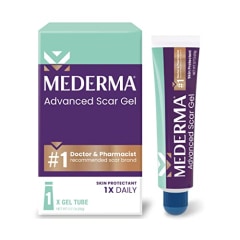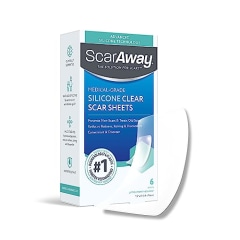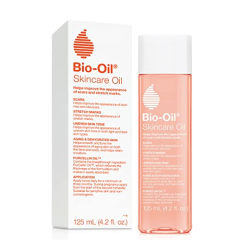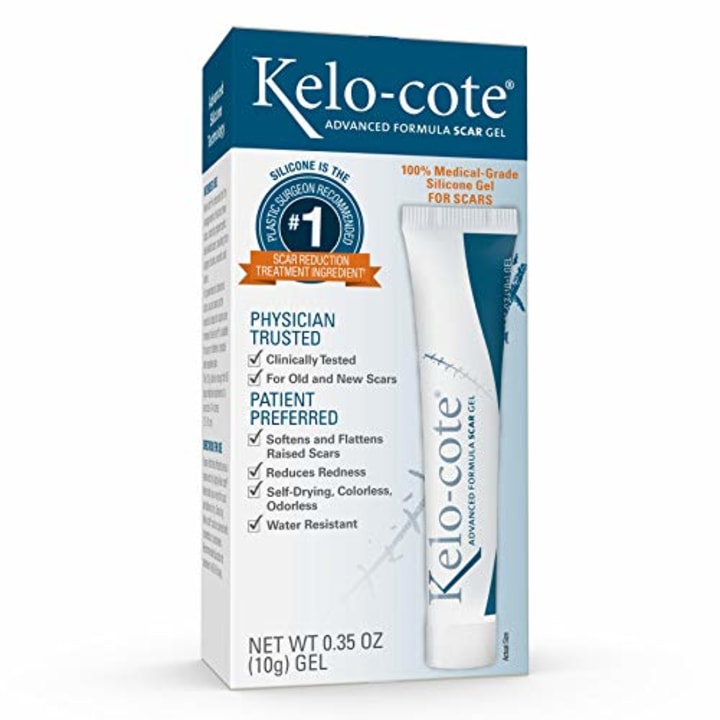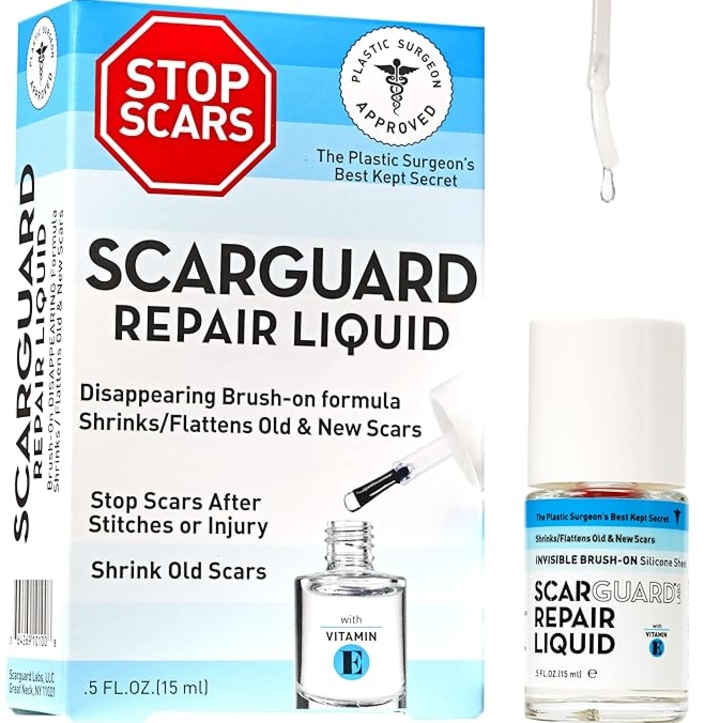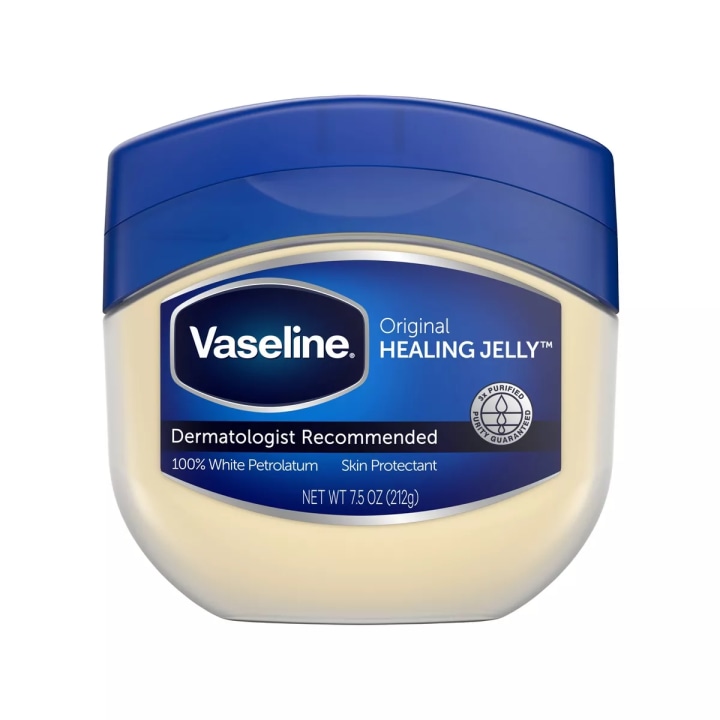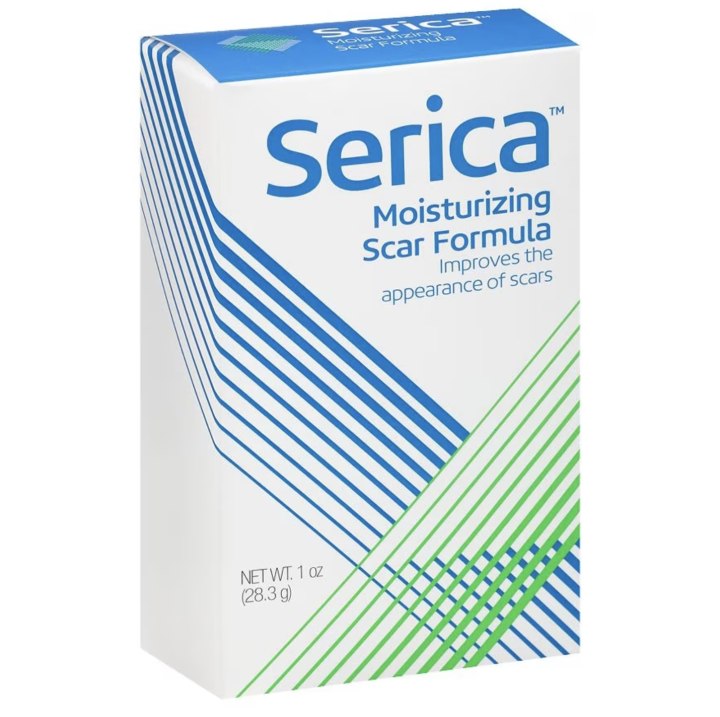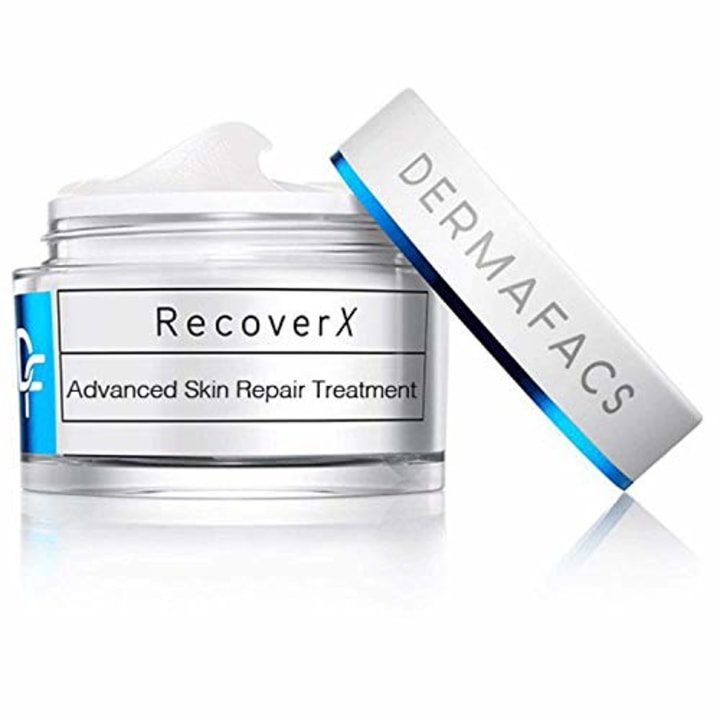Whether it’s from acne, surgery or another wound-inducing experience, scars are almost as inevitable as they are, by definition, permanent. You won’t find many over-the-counter products that’ll make them disappear, especially for deeper scars that create textural changes on your skin. In these cases, you will benefit most from medical interventions at your dermatologist’s office, according to our experts.
However, all hope isn’t lost: Medical and at-home treatments can help certain scars blend into the skin and make them less noticeable, according to dermatologists. Scar type and any color changes are a few factors to keep in mind when determining the best scar treatment for you.
To help guide your shopping, I spoke to dermatologists about the different types of scars you can get and whether at-home remedies can actually be effective at reducing their appearance. I also rounded up some over-the-counter options to shop based on their guidance.
SKIP AHEAD Best scar treatments | How do scars form? | What are the different types of scars? | Are color changes a form of scarring? | How to treat scars and color changes at home | In-office scar treatments
How we picked the best scar treatments
Keep in mind that over-the-counter treatments won’t do much to flatten raised scars, and most scars are best treated with in-office treatments like microneedling, chemical peels and lasers, according to our experts. However, if you want to minimize the appearance of a scar or hyperpigmentation, you may be able to treat it over time with gels, sheets and oils, depending on the severity and depth of scarring.
Here are the top expert-recommended ingredients that can help reduce the appearance of scars and color changes:
- Silicone: “After the wound closes, silicone gels can help the scar heal the best it can,” says Dr. Joshua Zeichner, director of cosmetic and clinical research at Mount Sinai Hospital. Silicone gels and sheets, which experts say have the best evidence of reducing the appearance of scars, form a seal over the skin to maintain skin hydration and protect it from the environment. Silicone sheets don’t typically flatten thick, raised scars, but they can prevent scar formation after a procedure or traumatic event, says Dr. Amy McMichael, professor of dermatology at Wake Forest University School of Medicine.
- Retinoids: These are prescription-strength treatments that help reduce hyperpigmentation, skin discoloration and some skin scarring by increasing skin cell turnover and stimulating collagen, according to our experts. “Tretinoin (topical retin-A) can help in early superficial scarring from acne and stretch marks, but [they are] not helpful for [raised scars like] hypertrophic scars and keloids,” says McMichael. Retinol, which is a weaker type of retinoid, is available over the counter, and it can help improve uneven skin tone and texture.
- Vitamin C: This is an antioxidant that can help reduce the appearance of redness and mild color changes. However, keep in mind that vitamin C will not treat the thickness of scars.
- Hydroquinone: Typically found in skin lightening creams, this ingredient can help fade red or brown dark spots caused by hyperpigmentation or color changes. However, it’s not available over-the-counter, and you’ll need a prescription. Like vitamin C, hydroquinone will not treat the thickness of a scar.
Best scar creams and gels
If you need help treating scars, our experts recommend consulting your dermatologist first. For at-home treatments, we highlighted dermatologist-recommended products below that can prevent wounds from turning into noticeable scars or minimize the appearance of existing scars.
Best scar gel: Mederma Advanced Scar Gel
This topical scar gel is a favorite among our experts because it can help flatten raised scars and minimize pain. The gel has Cepalin botanical extract, which helps lock in moisture, produce collagen and renew cells to reduce the appearance of scars from acne, burns, injury and surgery, according to the brand. Mederma recommends applying this treatment as soon as your wound closes and continue using it daily for at least eight weeks on new scars and three to six months on existing scars.
Best scar sheets: Scaraway Clear Silicone Scar Sheets
These clear, self-adhesive silicone sheets mimic the natural skin barrier and provide a moist environment, which allows the scar to heal better, according to Dr. Marisa Garshick, a board-certified dermatologist at MDCS Dermatology in New York City. “It helps to hydrate the skin, and the adhesive is comfortable and flexible, enabling you to keep the scar covered and protected while you heal,” she says.
In addition to protecting newly healed wounds, these patches also work to flatten and soften older, existing scars, which helps reduce their appearance, according to the brand. You can wear one for up to 10 days, and they’re water-resistant so they can withstand exposure to short-term moisture like showering, sweating and light rain, according to Scaraway.
Best for surgical scars: Kelo-Cote Advanced Formula Scar Gel
You can apply this silicone scar gel twice daily to reduce redness and soften raised scars, according to the brand. Zeichner recommends this gel to his patients after surgical procedures because it dries fully without leaving the skin feeling sticky, he says. The formula is also clear, non-greasy and water-resistant, according to Kelo-Cote.
Best SPF scar gel: BioCorneum Plus SPF 30 Silicone Scar Gel
The BioCorneum topical silicone treatment uses patented technology to help soften raised scars and minimize itching, redness and discoloration, says Garshick. It also has SPF 30, so it ensures your scar is protected from the sun, which our experts say is important to prevent scars from looking worse.
Best liquid scar sheet: Scarguard Repair Liquid
The Scarguard Repair Liquid is a brush-on silicone sheet that dries quickly to create a protective patch around a newly healed wound, says Garshick. You can apply twice daily to not only help prevent scars from forming but also shrink old scars, according to the brand. It’s water- and heat-resistant, and it has vitamin E to keep the area hydrated, according to our experts.
Best budget-friendly: Vaseline Healing Jelly
After the initial wound heals, you can massage ointments like Vaseline onto the injury to help soften any scar tissue, says Garshick. The ointment creates a protective barrier and helps keep the area moist to facilitate the healing process and minimize scab formation, she says. The Vaseline Healing Jelly is fragrance-free, noncomedogenic (it won’t clog pores) and has the National Eczema Association Seal of Acceptance, meaning it’s suitable for sensitive skin, according to the brand.
Best scar oil: Bio-Oil Body Oil
“Bio-Oil is a great, easy-to-find option for scars,” says Garshick. It combines plant extracts like calming chamomile (helps reduce redness) and calendula (has antibacterial effects) with vitamin A (helps stimulate collagen) and vitamin E (for hydration), she says. Bio-Oil is also noncomedogenic and great for stretch marks and uneven skin tone, according to the brand.
Best moisturizing scar gel: Serica Scar Gel
“Serica scar gel combines lipids with silicone to form a hydrating, protective seal over the skin to allow scar tissue to remodel,” says Zeichner. This formula helps improve the appearance of old and new scars, moisturizes the area to reduce texture and creates a more even skin tone, according to the brand. Serica recommends applying this gel three times a day, or as directed by your dermatologist.
Best splurge: Dermafacs RecoverX
Great for acne and face scars, this gel boosts hydration and helps penetrate the deeper layers of the skin using orthosilicic acid, a naturally occurring molecule that helps new healthy skin regenerate, says Garshick. The brand recommends applying a dime-sized amount twice daily using your hands or the included spatula. Apply the serum in circular motions until it’s fully absorbed into the skin, according to Dermafacs.
How do scars form?
Scars form as a result of the skin repairing itself after an injury, and they’ll often look and feel different than the surrounding skin, according to our experts. There are all kinds of scars, including surgical scars, stretch marks, acne scars and burn scars.
“After the initial wound healing phase, the skin undergoes new tissue formation as well as remodeling, and incorporates collagen to help with scar formation,” says Garshick. The way scars appear on the skin depends on how collagen is produced, which makes some scars more noticeable than others depending on the specific type of injury, the depth of injury, the location and other individual factors.
What are the different types of scars?
There are three main types of scars — atrophic, hypertrophic and keloid scars — and they vary significantly in appearance and shape, according to our experts. The type of scar and its physical appearance is a direct result of how your body chooses to heal after an injury, and there is no way to predetermine what type of scar will come from a specific injury, says Dr. Michele Farber, a board-certified dermatologist at Schweiger Dermatology Group.
Atrophic scars
Atrophic scars, also known as depressed scars, are indented on the surface of the skin. Usually associated with acne, this type of scar is caused by loss of collagen during the healing process and results in the thinning of the skin, says Dr. Robyn Gmyrek, a board-certified dermatologist at UnionDerm in New York City. These scars can also sometimes appear lighter than the color of your skin if there is not enough collagen production during the wound healing and skin remodeling process, says Garshick.
There are three different types of atrophic scars based on their shape, according to our experts:
- Icepick scars are narrow, deep scars in the skin that form a hole or V-shape.
- Boxcar scars are square-shaped depressions with sharply defined edges.
- Rolling scars have sloping edges. “They are usually a bit wider and give a curved atrophic appearance to the skin,” says Gmyrek.
Stretch marks are also a type of atrophic scar caused by the skin stretching or shrinking quickly. These scars are thin and slightly indented, and can appear white, pink, purple or blue in color, according to our experts.
Hypertrophic scars
Hypertrophic scars appear raised and thickened on the skin. They usually occur when the body produces too much collagen at the site of the wound during the healing process, according to Farber.
Keloid scars
Like hypertrophic scars, keloids are raised and hairless scars that are usually pink, red or flesh-toned. However, unlike hypertrophic scars, which are contained within the area where the injury once was, keloid scars grow beyond the borders of the original injury, according to Dr. Zakia Rahman, a board-certified dermatologist, clinical professor of dermatology and director of the Resident Laser and Aesthetic Clinic at Stanford Health Care.
“Scars remodel for up to one year after trauma, but keloids, which are scars that grow out the boundaries of the trauma border, can continue to grow for years,” says McMichael. Keloids might also turn darker than your usual skin color when exposed to the sun, experts say.
Keloids are also the hardest type of scars to treat. “We can remove them and employ lasers, topical therapies and radiation, but they are very unpredictable and have a high recurrence rate,” says Dr. Mara Weinstein Velez, a board-certified dermatologist and assistant professor with the University of Rochester Medical Center.
Are color changes a form of scarring?
Residual discoloration or color changes, which usually look like red or brown marks on the skin, are common after an injury, and often discussed interchangeably with scarring. However, they’re not the same: Color changes are easier to treat and will usually go away over time (especially with consistent use of retinoids), but scars are permanent.
Scars can be different colors, too. Some appear brown due to discoloration, while others appear white when pigment is lost, says Garshick. Some scars may initially show up as pink or red on the skin due to new blood vessels forming, she says.
There are two main types of color changes, according to our experts:
- Post-inflammatory hyperpigmentation, which results from the overproduction of melanin after inflammation on the skin.
- Post-inflammatory erythema, which causes red or pink patches on the skin due to inflammation.
“Oftentimes, patients come in thinking they have scars when really they are just areas of hyper or hypopigmentation,” says Weinstein Velez. “Pigmented areas can take months to improve, but they can resolve over time. But when there is a cut in the skin like a surgical scar or a traumatic scar, or any type of injury that leads to a scar, that will be permanent.”
How to treat scars and color changes at home
Once scars develop, they are permanent, but there are some ways to reduce their appearance. Dermatologists told us the best treatments for scarring are only offered in the dermatologist’s office, and they include lasers and microneedling treatments.
Depending on the type of injury and extent of the wound, you should first focus on proper wound care to help that top layer of skin heal as quickly as possible, says Rahman. “Keeping that area clean with soap and water and then keeping it covered as much as possible prevents a scab,” she says. You should also always protect scars from the sun. “The last thing you want to do is to develop hyperpigmentation or a burn in the area of new scar tissue,” says Zeichner.
Below, we list a few treatments available over-the-counter that can help reduce redness, inflammation and itching associated with scars. Keep in mind that drugstore products won’t significantly flatten scars, but rather they prevent them from forming in the first place or reducing redness, according to McMichael. To actually flatten scars, you’ll need prescription topicals, injections or other invasive ambulatory treatments like liquid nitrogen or lasers, she says.
Silicone and hydrocolloids
Silicone — either in the form of sheets, creams or gels — is one of the most effective treatments for reducing the appearance of scars and preventing them from forming, experts told us. Silicone works as an occlusive barrier for the scar, which means it creates a seal over the surface of the skin. It helps keep the area hydrated, protects it from the environment and regulates collagen production to minimize the possibility of a scar forming in the first place, according to Garshick. Silicone also calms the skin, which helps reduce the itching that comes with scarring. However, while it may help with redness, silicone is not very effective at treating pigmentation, says McMichael.
Silicone sheets are most effective at improving scars because they apply gentle pressure and can alleviate tension and soften the scar, says Garshick. You may also come across hydrocolloid dressings, which are very similar to silicone sheets. Hydrocolloids are patches that you can place on an injured area to help heal the critical top layer of the skin faster, says Rahman. They also reduce movement and stretching around the cut or injury — especially in high-tension areas like the chest or back where you’re more likely to get a bad scar — to help the healing process, she says.
Retinoids
Experts told us prescription retinoids like tretinoin (known as Retin-A) and tazarotene have been shown to be effective as a long-term topical treatment to reduce the appearance of color changes, acne scars and stretch marks. “Since retinoids work to help boost collagen production, they can help with textural changes and improve the appearance of discoloration,” says Garshick. However, retinoids aren’t very helpful for deeper scars like hypertrophic scars and keloids, according to McMichael.
Keep in mind that retinoids can be irritating on the skin, so it’s important to avoid overusing it to prevent redness and sensitivity of the skin, says Garshick. Make sure you’re only using it a few times a week, depending on how your skin tolerates the formula.
Retinol, which is available over the counter, can also help reduce the texture of a scar, but it won’t be as effective as stronger prescription retinoids, experts say.
Vitamin C
Vitamin C is a powerful antioxidant that can help brighten the skin and improve the appearance of hyperpigmentation and discoloration, says Garshick. This ingredient can be great to help minimize older scars because they tend to be darker brown in color, according to Zeichner. However, keep in mind that vitamin C won’t improve the thickness of scars, says McMichael.
Chemical exfoliants
If your main concern is slight textural changes or discoloration, chemical exfoliants can help. These include alpha-hydroxy acids (AHAs) like lactic acid and mandelic acid, and beta-hydroxy acids (BHAs) like salicylic acid, which help unclog pores, exfoliate skin and even out skin tone. AHA/BHA peels are great for fixing uneven skin texture and improve mild discoloration on the skin, according to our experts.
In-office scar treatments
There are certain in-office treatments that dermatologists offer that can help reduce the appearance of both raised and depressed scars over time, including laser resurfacing, microneedling and injectable fillers. Most of these treatments cause a controlled tissue injury that helps the body heal itself, says Rahman.
Atrophic scar treatments
Your dermatologist can treat atrophic scarring with laser resurfacing, which uses light energy to stimulate new collagen and improve the appearance and texture of a scar, says Garshick. Another option is microneedling, which creates small holes in the skin that also help stimulate collagen, she says. You can treat atrophic acne scars with an in-office procedure called subcision, which lifts the scar tissue upward to reduce the depression in the skin. You can also consider filler injections to replace volume if a scar is indented, according to our experts.
Ice pick scars are harder to treat because they’re deeper in the skin. To improve this type of atrophic scar, dermatologists recommend a Chemical Reconstruction of Skin Scars (CROSS) procedure, which uses trichloroacetic acid to help boost collagen production. You’ll need several treatments performed at least one month apart in order to see results, says Gmyrek.
Hypertrophic and keloid scar treatments
Hypertrophic scars and keloids can be treated with laser resurfacing treatments to remodel the thick scar tissue. This is usually in conjunction with steroid injections, which can help soften and flatten the scar, as well as decrease inflammation and improve redness, says Garshick. Studies also show that injecting a scar with botulinum toxin (commonly known as Botox) provides the same benefits as steroid injections in terms of reducing redness and itching, says Rahman.
Hyperpigmentation and discoloration treatments
Certain lasers can help reduce those color changes, along with prescriptions that increase cell turnover like retinoids and skin lightening creams like hydroquinone can help fade those red or brown spots, according to experts. Lasers, chemical peels and lightening creams may be helpful in cases of discoloration. In-office chemical peels performed by dermatologists and aestheticians help with skin turnover and can treat pigmentation left behind by scars, says Garshick.
Meet our experts
At NBC Select, we work with experts who have specialized knowledge and authority based on relevant training and/or experience. We also take steps to ensure all expert advice and recommendations are made independently and without undisclosed financial conflicts of interest.
- Dr. Joshua Zeichner is a board-certified dermatologist, associate professor of dermatology and the director of cosmetic and clinical research at Mount Sinai Hospital. He specializes in cosmeceuticals, skin care and cosmetic dermatology.
- Dr. Amy McMichael is a board-certified dermatologist and professor of dermatology at Wake Forest University School of Medicine.
- Dr. Marisa Garshick is a board-certified dermatologist at MDCS Dermatology in New York City and an assistant clinical professor of dermatology at NewYork-Presbyterian/Weill Cornell Medical Center.
- Dr. Robyn Gmyrek is a board-certified dermatologist at UnionDerm in New York City.
- Dr. Michele Farber is a board-certified dermatologist at Schweiger Dermatology Group in Philadelphia. She specializes in skin cancer treatments, as well as general, cosmetic and procedural dermatology.
- Dr. Zakia Rahman is a board-certified dermatologist, clinical professor of dermatology and director of the Resident Laser and Aesthetic Clinic at Stanford Health Care. She also serves as the assistant chief at the Palo Alto VA Medical Center-Livermore.
- Dr. Mara Weinstein Velez is a board-certified dermatologist and assistant professor with the University of Rochester Medical Center. Her areas of research include cosmetic dermatology, skin of color, scarring and hair growth.
Why trust NBC Select?
Mili Godio is an updates editor at NBC Select who has covered a variety of skin care topics, including products for rosacea, keratosis pilaris and cystic acne. For this article, Godio spoke to seven dermatologists to narrow down the best scar treatments, and highlighted their recommendations for the best products to consider.
Enter to win an iPad from NBC Select. We’re giving away an iPad to one lucky winner who fills out our survey about shopping interests and habits. (NO PURCHASE NECESSARY. Void where prohibited. Legal residents of the 50 US states or DC who are 18 or older. Ends 5/31/24. Limit 1 entry per person. Sponsors: NBC Select and NBCUniversal Media, LLC.)
Catch up on Select’s in-depth coverage of personal finance, tech and tools, wellness and more, and follow us on Facebook, Instagram, Twitter and TikTok to stay up to date.
